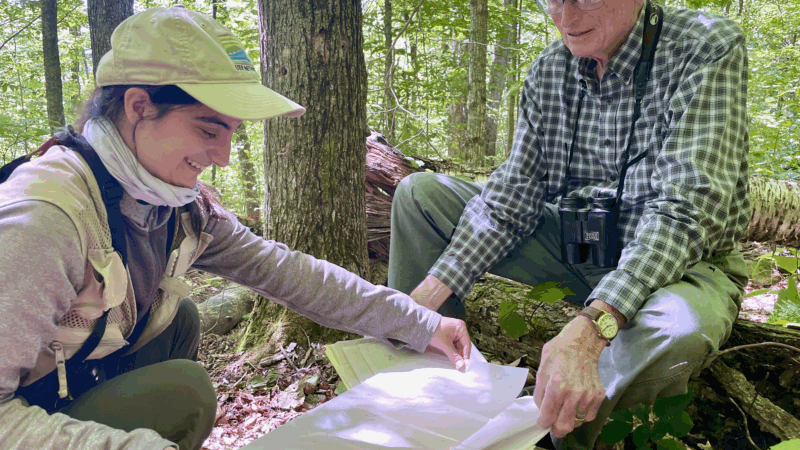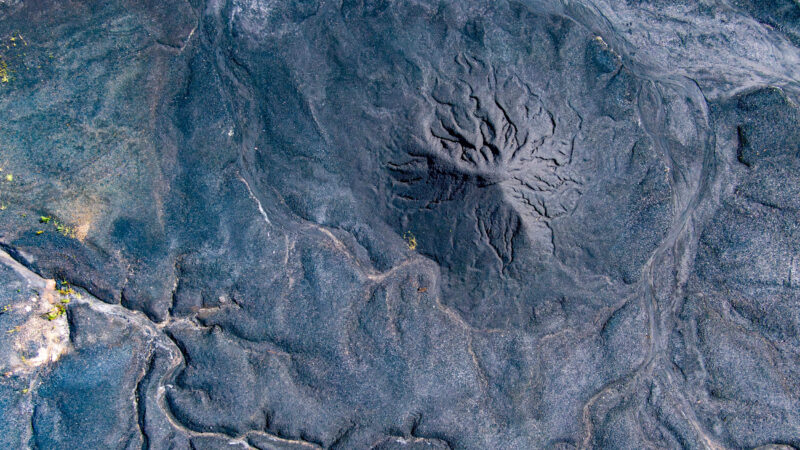By listening to these birds for decades, scientists track signs of a changing forest
Miranda Zammarelli hikes into the Hubbard Brook Experimental Forest in central New Hampshire, pausing when she sees a tree with a pink ribbon wrapped around its trunk.
Zammarelli, a behavioral ecologist and PhD candidate at Dartmouth College, knows that ribbon well. It marks the corner of a 25-acre field site first established in 1969 to map the territories of the songbirds inhabiting it.
Her task now is simply to wander, wait and listen.
On this early morning in June, it doesn’t take long before a soft melody wafts down from the treetops. “That’s a black-throated blue warbler,” murmurs Zammarelli with a kind of reverence.
She uses a mapping app on her phone to input the location of the bird based on where she’s just heard him. The warbler’s small enough to fit in the palm of her hand, but this is breeding season and he’s got something big to say.
“He is singing right now because this is his territory,” she says. “So one bird sings, another bird responds. They’re basically having what I call a territorial rap battle. ‘Hey, this is my space, stay away.’ And the other bird’s like, ‘No, this is my space, stay away.’ And they’re singing back and forth trying to claim their spot.”
A male’s territory is where he’ll attract his mate and raise his young, so there’s a lot riding on his song.
Zammarelli and others have been mapping these territories for the last month and a half, documenting where some two dozen species of songbirds are located. These birds are high up in the food web, and they help disperse seeds and eat insects. Many of them are migratory, traveling between here and the Caribbean or Central or South America.
It’s important to understand these territories, says Zamarelli, because they offer a window into “the quality of the forest habitat for these birds.” Territories mean the forest is a healthy place for birds. “If birds are not using the habitat or less likely to have a territory there,” she says, “we can begin asking why.”
The territory maps go back decades. Before the cell phone app, they were all sketched by hand.
Seeing the forest for the birds
Dick Holmes gridded out and launched this field site back when he was just starting out as a biologist at Dartmouth. Today, he’s almost 89, and a professor emeritus.
“We have maps for every species for each of the 57 years,” he says, unfolding one of them. “So all the observations, you add ’em up from day to day, and you end up with a seasonal pattern showing all the different territories on the plot.”
The maps are swarms of X’s, arrows, dotted lines, and circles, the latter of which delineate the territories.
In the beginning, Holmes had a fairly simple question. He wanted to know how energy flows through an ecosystem — that is, how songbirds fit into the food web of their forest.
“How much energy do they use?” he says. “Where do they get their food?”
As Holmes and his team gathered more information on the birds year after year, their questions evolved. “We got interested in what determines the number of birds and why are their numbers increasing or decreasing,” he says.
For instance, the researchers heard a bird called the least flycatcher on the plot for the last time in 1994. And the American redstart — a jetblack little fellow with orange splashes — pretty much stopped breeding here in the early 2000s.
The primary reason appears to be that the forest — which had been clearcut in the 1920s and then left to regrow, undisturbed — has been aging and changing ever since. “It’s naturally growing, and we’re seeing how the bird populations and bird communities change as a result of this natural growth,” says Zammarelli.
That is, the ups and downs of these little songbirds have revealed how the forest around them has grown up. It’s a result that matches work done elsewhere, including a classic 1950 study from the southeastern U.S.
“There’s some species that seem to do well in a young forest,” says Holmes. “And as that forest ages, those changes cause the birds to move elsewhere.”
This field site has hosted hundreds of students and yielded over 200 scientific publications, all of which depended on poring over those paper maps — until Zammarelli began her PhD a few years back and her advisor, Matthew Ayres, asked if she knew anyone who could digitize them.

“I was like, ‘I can do it,'” she recalls responding. “I had digitized collections before. That would be no problem at all.”
Holmes applauds Zammarelli’s efforts. “I had not even thought of the idea of digitizing, frankly, but I was glad to see it done,” he says. “Miranda’s done a bang-up job.”
A solid past, a flighty future
Getting the 50-plus years of maps into the computer enabled Zammarelli to bring the data to life in a new way and ask new questions. “That allowed us to look at how these birds are using the space, where are they using the space, and also how big of a territory they’re occupying in the habitat,” she says.
In a paper published in Ecology Letters late last year, Zammarelli and her colleagues considered seven species and found that birds, no matter the number, divide the habitat up equally. That means lots of chicks, which help keep songbird populations stable over time.
It’s a finding made possible by decades of mapmaking. “I think about all the hands these maps touched,” reflects Zammarelli. “This data’s like twice my lifetime. I feel very lucky and very grateful to be a part of a system that has been going on for over 50 years.”
To his knowledge, Holmes says this is the longest detailed record of breeding birds anywhere in the U.S., possibly the world.
“It’s important in terms of understanding what we’re doing to our environment,” he says. “Things are changing rapidly for various reasons … climate change being one. And trying to understand why these are happening, and how they’re happening is quite important.”
But he says the project now finds itself in a precarious place.
“Now, with the budgets being cut by the current administration, it’s hard to tell what’s gonna happen in the next few years,” says Holmes.
But at least for the next few minutes, Holmes and Zammarelli know exactly what will happen. The birds will continue to fill the air with melody, singing the collective song of their forest.
Transcript:
JUANA SUMMERS, HOST:
In 1969, a team of researchers mapped the territories of songbirds inhabiting a patch of forest in central New Hampshire. For more than half a century, that work has continued, revealing insights about the birds and their changing home. Science reporter Ari Daniel went to visit.
ARI DANIEL, BYLINE: The patrol begins every morning. It’s late June, and I follow Miranda Zammarelli, a Ph.D. candidate at Dartmouth College and a behavioral ecologist, into the Hubbard Brook Experimental Forest.
MIRANDA ZAMMARELLI: If you look ahead, you’ll see a tree that says A1 on it.
DANIEL: It’s got that pink ribbon around it.
ZAMMARELLI: Yes. That tree is just an indicator that we’re on the plot now.
DANIEL: We’re standing at the northeast corner of a 25-acre grid, which is basically Zammarelli’s outdoor office.
ZAMMARELLI: Now that I’m on the plot, my job is just to sort of wait till I hear this next bird and then try to accurately pinpoint where that bird is.
DANIEL: So you just kind of wander and wait and listen.
ZAMMARELLI: Yes.
DANIEL: OK. In we go.
(SOUNDBITE OF BLACK-THROATED BLUE WARBLER CALL)
ZAMMARELLI: Did you hear that?
DANIEL: Yeah.
ZAMMARELLI: That’s a black-throated blue warbler. So I’m going to mark him.
(SOUNDBITE OF BLACK-THROATED BLUE WARBLER CALL)
DANIEL: Zammarelli uses a mapping app on her phone to input the location of the bird based on where she’s just heard him. The warbler’s small enough to fit in the palm of her hand, but this is breeding season, and he’s got something big to say. So do other warblers in the forest.
ZAMMARELLI: They’re basically having what I call a territorial rap battle. Hey, this is my space, stay away. And the other bird’s like, no, this is my space, stay away. And they’re singing back and forth, trying to claim, like, their spot.
DANIEL: That spot is where the bird will attract his mate and raise his young, so high stakes. Zammarelli and others have been mapping these territories for the last month and a half, documenting where some two dozen species of songbirds are located. The researchers say the birds play important roles in their ecosystem. They’re high up in the food web, and they help disperse seeds and eat insects. The territory maps, they go back decades. Before the cell phone app, they were all sketched by hand.
DICK HOLMES: We have maps for every species for each of the 57 years.
DANIEL: Dick Holmes, who’s here in the forest with us, as well, unfolds one of the paper maps. He launched this whole thing back when he was just starting out as a biologist at Dartmouth. Today, he’s almost 89 and a professor emeritus.
HOLMES: So all the observations, you add them up from day to day, and you end up with a seasonal pattern showing all the different territories on the plot.
DANIEL: Those territories are delineated by circles on the maps, crisscrossed by a swarm of arrows and dotted lines. In the beginning, Holmes had a fairly simple question. How do songbirds fit into the food web of the forest? As he and his team gathered more information on the birds year after year, their questions evolved.
HOLMES: We got interested in what determines the number of birds, and why are their numbers increasing or decreasing?
DANIEL: For instance, the researchers heard a bird called the least flycatcher on the plot for the last time in 1994, and the American redstart, a jet-black little fella with orange splashes, pretty much stopped breeding here in the early 2000s. The primary reason, says Miranda Zammarelli, appears to be that the forest, which had been clear cut a century ago and then left to regrow undisturbed, has been aging and changing ever since.
ZAMMARELLI: It’s naturally growing, and we’re seeing how the bird communities change as a result of this natural growth.
DANIEL: That is, the ups and downs of these little songbirds have revealed how the forest around them has grown up, a result that matches work done elsewhere. This field site’s yielded over 200 scientific publications, all of which depended on poring over those paper maps until Zammarelli began her Ph.D. a few years back and her advisor asked if she knew anyone who could digitize them.
ZAMMARELLI: I was like, I can do it. I had digitized collections before.
DANIEL: And getting the 50-plus years of maps into the computer enabled Zammarelli to bring the data to life in a new way.
ZAMMARELLI: So that allowed us to look at how these birds are using the space and also how big of a territory they’re occupying in the habitat.
DANIEL: In a paper published in Ecology Letters, Zammarelli and her colleagues found that birds, no matter the number, divide the habitat up equally. It’s a finding made possible by decades of mapmaking.
ZAMMARELLI: I think about all the hands these maps touched. I feel very grateful to be part of a system that has been, you know, going on for over 50 years.
DANIEL: In his view, Holmes says that we’re in a moment of great environmental change, which makes a long-term study like this one more important than ever. But he says the project’s in a precarious place with the federal government slashing science budgets.
HOLMES: It’s hard to tell what’s going to happen in the next few years.
DANIEL: But at least for the next few minutes, Holmes and Zammarelli know exactly what’ll happen. The birds will continue to layer the air with melody, singing the collective song of their forest.
(SOUNDBITE OF BIRD CHIRPING)
DANIEL: For NPR News, I’m Ari Daniel, Woodstock, New Hampshire.
(SOUNDBITE OF AMIE BLU SONG, “EVERYTHING ABOUT HER”)
Auburn fires coach Hugh Freeze following 12th loss in his last 15 SEC games
The 56-year-old Freeze failed to fix Auburn’s offensive issues in three years on the Plains, scoring 24 or fewer points in 17 of his 22 league games. He also ended up on the wrong end of too many close matchups, including twice this season thanks partly to questionable calls.
In a ‘disheartening’ era, the nation’s former top mining regulator speaks out
Joe Pizarchik, who led the federal Office of Surface Mining Reclamation and Enforcement from 2009 to 2017, says Alabama’s move in the wake of a fatal 2024 home explosion increases risks to residents living atop “gassy” coal mines.
‘It’s like feeling the arms of your creator just wrapped around you’: a visit to a special healing Shabbat
Members of Temple Emanu-El in Birmingham gathered recently for their traditional Friday Shabbat service. But this particular service was different, as could be seen by all the people dressed in their finest pink.
Space Command is coming to Huntsville. What might that mean for first-time homebuyers
While Huntsville has been a more affordable market than other growing cities, what’s it been like for those looking for their first home?
Colorado says relocation of Space Command to Alabama is ‘punishment’ for mail-in voting
The litigation announced by Colorado Attorney General Phil Weiser asks a federal judge to block the move as unconstitutional.
Breaking down Alabama’s CHOOSE Act
It’s been a year since Alabama legislators passed the CHOOSE Act allowing families to apply for state funds to use towards homeschool expenses and tuition for participating private schools. The Alabama Daily News’ education reporter Trisha Powell Crain has been diving into how the funds are being used. WBHM’s Andrew Gelderman sat down with her to talk about what we’re seeing so far.









